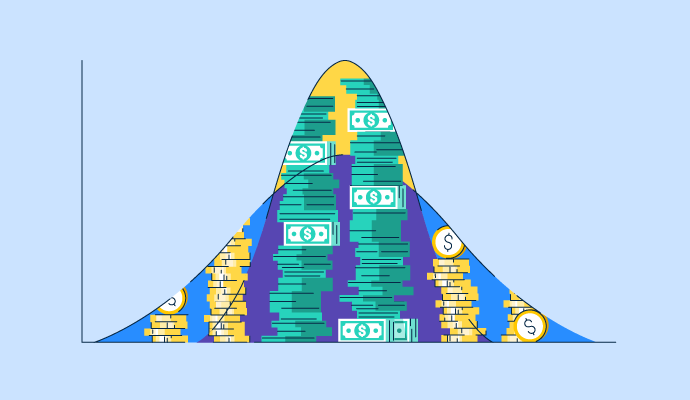
Metaverse means “beyond the universe” and was introduced to us by authors like Neal Stephenson in “Snow Crash,” Ernest Cline in “Ready Player One,” and William Gibson in “Neuromancer.”.
As the idea became bigger with increasing investment and development, it now plays an important role in the digital world, from education to gaming. Businesses, from gaming companies to enterprises are experimenting with augmented reality (AR) tools and virtual reality software to create novel immersive experience in metaverse.
But how many people use metaverse? Who are the key players in the virtually immersive industry? How big is the metaverse market? Is Metaverse really growing? Let’s look at relevant numbers that shed light on this new, big digital realm.
In the last two years, before generative AI became the buzzword, Metaverse was booming. But is it still? The statistics below show that Metaverse still has its mojo with the technology getting traction.
- There are 600 million unique users using Metaverse in 2024, including users in platforms like Robolox, Fortnite, Minecraft and other immersive reality apps that are in alpha and beta testing.
- People search the term metaverse around 446,000 times per month worldwide.
- The metaverse’s reach is projected to be 2.6 billion people by 2030.
- 95% of business executives see a positive impact of metaverse on their industry within 5 to 10 years.
- An impressive 68% of tech pundits are betting on the metaverse to make significant waves in the next half-decade.
- Robolox, the popular metaverse gaming platform, has over 77.7 million daily active users of Roblox games.
- 79% of active users on the metaverse have made a purchase.
- 54% of technology experts expect the metaverse to be a much-more-refined and truly fully-immersive by 2040.
- Meta, formerly Facebook, has funneled nearly $50 billion into Meta’s Realty Labs division for metaverse development.
- Meta’s Reality Labs division hit $1 billion for the first time in the quarter ended on Dec,31, 2023.
- The niche of virtual fitting rooms in retail is predicted to soar from $4.03 billion in 2022 to $13 billion in 2028.
Metaverse market and industry statistics
“Is metaverse dead?” is the question that people ask about the industry and technology in 2024. However, numbers show that Metaverse is living its moment as businesses develop real-world applications of the technology after the initial hype cycle.
- The global metaverse market will be worth a whopping $936.6 billion by 2030.
- Goldman Sachs, a global financial titan, sees the metaverse as a potential goldmine, estimating its value at a massive $8 trillion. This sentiment is echoed by numerous industry experts who predict significant growth in its valuation.
- The market size of metaverse in e-commerce alone reached $34.65 billion in 2023 and is will hit around $936.28 billion by 2033.
- 278 metaverse companies raised roughly $530 million in 2023 through funding rounds.
- Investments in metaverse companies on the whole was at $9.72 billion in 2023.
- The market cap of extended reality sector which is part of immersive reality technology, is projected to touch $252 billion by 2028, from $92.88 billion in 2022.
- Investment in VR/AR, which forms the bedrock of the metaverse, will be an impressive $72.8 billion by 2024, from just $12 billion in 2020. Consequently, frontrunners across sectors like gaming, retail, arts, healthcare, and blockchain are strategizing to establish their presence in this domain.
- The collective market cap for AR, VR and mixed reality (MR) will be $250 billion by 2028.
- The user penetration of metaverse market will be 14.6% in 2024 and is expected to reach 39.7% by 2030.
Metaverse technology statistics
On the technology side,AR and VR technology have seen significant investments over the past few years. Sectors such as VR headsets and mobile AR are predicted to become a multi-billion dollar market in the foreseeable future. Non-fungible tokens (NFT), powered by blockchain technology, to record ownership of things in the metaverse also remains notable. The statistics below tell about the growth of technology powering metaverse.
- Forecasts suggest that AR and VR headset shipments could reach 23.22 million in 2023, 32.76 million in 2024, and a potential 43.87 million by 2025.
- More than 34 million VR headsets will be in use by 2024.
50%
of US adults feel more affordable VR headsets are vital in propelling metaverse adoption.
Source: Morning Consult
- The AR and VR market revenue projection is $31.12 billion in 2023, escalating to $52.05 billion by 2027.
- Mobile AR users worldwide are set to increase exponentially, from 200 million in 2015 to a staggering 1.7 billion by 2024.
- 66% of respondents believe XR will revolutionize virtual learning.
- 53% of consumers are open to shelling out over $300 on entry-level VR headsets and accompanying controllers.
- Global sales of XR headsets are on course to triple by 2025.
- Meta holds 90% of the VR headset market. Following Meta is ByteDance’s Pico, with a 4.5% share.
- By 2028, 16.35 million will be using NFT marketplace.
Metaverse usage statistics
People use the metaverse differently. Some use it to play games, while others leverage its capabilities to socialize virtually. The statistics below cover the many other reasons people love to use the metaverse.
- Every month, the metaverse attracts over 600 million active participants, a significant portion being young teens. Platforms like Roblox, Fortnite, and Minecraft are particularly favored by those aged 12-13.
- Robolox has nearly 78 million active users. Sandbox, another immersive gaming platform, has 5.8 million user accounts.
- 8 out of 10 metaverse users (84%) use the platforms for personal enjoyment.
- The average user spending across all metaverse platform is $328 per user.
- Research suggests that businesses delving into the metaverse primarily target large corporations, males, and the Gen Z demographic. They slightly prioritize men (11.3%) over women (8.6%) and find larger enterprises three times as attractive as small to medium-sized businesses.
70%
of individuals between 16 and 44 are acquainted with AR technology, even though it’s relatively new. Its adoption mirrors the rise of online shopping.
Source: Threekit
- The valuation of virtual art galleries has touched $2.4 billion, with projections of further growth in 2023. Given the surge in NFTs and virtual reality interest, artists are increasingly leaning into this digital medium. This allows art enthusiasts to indulge in immersive experiences from the comfort of their homes, minus the hassle of maintaining physical artwork.
- A whopping 400 million people globally engage with the metaverse regularly.
- Over a quarter of worldwide consumers are keen to explore virtual experiences.
- A metaverse user survey highlighted three primary benefits: the thrill of tackling real-time challenges (39%), fostering creativity and imaginative thinking (37%), and digitally touring the globe (37%).
- NordVPN and Propeller Insights state that 25% of American adults contemplate the metaverse as a potential successor to traditional social media platforms.
- 39% of American adults believe the metaverse can facilitate experiences otherwise inaccessible to them in the physical realm.
- Marketing in the metaverse is growing. AB InBev’s collaboration with Zed Run to market, breed, and sell NFT horses supports this. Once valued at $30, these NFTs now command prices as high as $165,000.
Metaverse gaming and event statistics
Prominent stars like Ariana Grande, Travis Scott, and Post Malone have taken center stage in the metaverse, showcasing the platform’s entertainment potential. 2023 is seeing a surge in metaverse events from Seoul to Las Vegas.
Moreover, the first-ever Metaverse Beauty Week in June 2023, hosted by CULT, bridged virtual and physical realms, with the spotlight on top beauty brands in London and online platforms. Cult’s team is working in partnership with global beauty brands and connecting them with digital designers. The statistics below showcase people’s preference for metaverse for events and gaming.
- In 2023, Metaverse in gaming industry was valued at $22.7 billion and will reach $119 million by 2028.
- 1 out of 2 US gamers believe that the metaverse will change the game industry.
- 7 in 10 VR headset users play games with their devices.
- 60% of gamers have turned to the metaverse for activities beyond gaming, such as virtual socialization and e-shopping.
- Gamers in Robolox spent 16.7 billion hours on the platform in just 3 months.
- Every month, roblox sees on average of 15+ million unique paying customers.
- Fortnite’s event featuring Galactus attracted a staggering 15.3 million gamers and witnessed 3.4 million viewers across platforms like YouTube Gaming and Twitch.
- Topping the list of most attended Metaverse concerts are Travis Scott with 45.8 million viewers, Lil Nas X at 37 million, Ariana Grande with 27 million, 24KGoldn drawing 14.6 million, and 21 Pilots pulling in 13.4 million attendees.
59%
of metaverse gamers are males, boasting an average age of 27 – notably younger than the broader gaming demographic.
Source: Newzoo
- Metaverse music events found the highest traction among millennials: 32% showed moderate enthusiasm, while 29% were extremely keen. Gen Z had mixed reactions, with 32% slightly intrigued and 30% expressing disinterest. The interest dwindled significantly among the baby boomer demographic.
Concerns and risks associated with metaverse: key statistics
Although it has several benefits and use cases, metaverse does raise eyebrows if you mention security and privacy. Many people are concerned about their mental health and its addictive nature. Others have expressed their thoughts on personal data privacy within the metaverse. Let’s explore key statistics highlighting common concerns and risks related to the metaverse.
- There’s a rising concern, with 41% of users feeling that metaverse usage may lead to mental health issues.
- In a survey of 1,000 people, nearly half view potential addiction as the most alarming risk linked to the metaverse.
- The metaverse community champions the prohibition of themes like suicide, animal abuse, hate discourse, and online harassment. Interestingly, under 50% of survey participants felt that content related to drugs and alcohol should be restricted.
- Privacy remains a primary concern, with 41% of users anticipating breaches.
- A significant 77% believe the metaverse might adversely affect real-world interactions.
- 46% of users expect that within a decade, they might lean toward living primarily in the metaverse.
34%
of online users express concerns about data security within the metaverse.
Source: Telus International
- 18% of voice concerns about potential exposure to inappropriate content within the metaverse.
- 26% of respondents foresee a surge in cyber crimes due to the metaverse’s growth.
- 54% of those surveyed are inclined to design a metaverse avatar distinct from their real-life appearance.
Entering a space made of pixels
Imagine watching a soccer game with complete immersion or reliving historical events visually. These aren’t just fantasies anymore; they’re realities in the making.
The metaverse is rapidly becoming popular, and the statistics above suggest that it is poised for monumental growth in 2023 and beyond. Gaming and e-commerce will thrive, and virtual real estate and music events will gain traction.
The next phase of the metaverse will likely be driven by marketing and advertising. Many brands have recognized its potential and are laying the foundation for their virtual presence.
While still in its early stages of development, the possibilities of the metaverse are endless when applied to how we work, live, and play.
Explore what the metaverse means for the software development sector.
This article was originally published in 2023. It has been updated with new information.
Sagar Joshi is a former content marketing specialist at G2 in India. He is an engineer with a keen interest in data analytics and cybersecurity. He writes about topics related to them. You can find him reading books, learning a new language, or playing pool in his free time.





